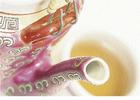
Rosalee Brown
Tea has been around for centuries and is associated with many legends in China. The growing and trading of tea was very big business in 'those early days' and tea was very expensive because of the length of the voyage (almost a year) and the then monopoly.
The Dutch were the first tea drinkers outside of Asia. Tea arrived in Britain in the 1650s and was the drink of only royalties and the super rich until tea drinking spread to the United States and the rest of the colonies. In 1883, the monopoly on tea ended and with the reduction of tea taxes, tea could be had by the common man.
It is said that tea replaced alcohol for many as an after-meal drink and also became an afternoon drink before dinner, starting the trend of afternoon high teas in the 1840s.
Camellia Sinensis (tea) is now grown across the world in tropical and subtropical regions.
The tea tree can grow very tall in the wild but those cultivated for their delicate young leaves and buds are kept below six feet. A tea bush can have a 75-year life or longer, depending on its care. Harvesting tea is very labour intensive as 100lb of green leaves will only make 20lb of finished tea.
Colour and flavour
The process of making tea varies in length of time according to the finished product required. It is first withered to remove up to 70 per cent of the moisture; it is then rolled and torn mechanically. The tea starts fermentation during rolling and oxidation creates the varying colours, strengths and flavours. Teas are then sorted and graded according to specifications such as type and leaf size.
Black tea is fermented, dried and then divided into whole leaves, broken leaves, fanning and dust. The dust is found in tea bags and has the ability to brew a strong tea quickly. Oolong tea is fermented for a shorter period than black tea and is 'in-between' in colour.
Green tea is not fermented before it is fired (dried), it is graded according to the size of the tea leaves at its source and the way it is rolled.
Health benefits
Although tea was touted as being healthy in the early days, it was often adulterated with alcohol, other herbs and even animal dung.
Many health benefits are ascribed to tea because of its content of flavonoids. Some interesting news on tea from the European Heart Journal published by Science Daily, showed that the beneficial effect of the catechins in black tea is rendered ineffective by milk!
The casein in milk was found to be the culprit. The study was carried out on 16 healthy menopausal women. They were fed half litre of black tea, black tea with milk and water on three separate occasions then tested. The investigators found that drinking tea increased the ability of the artery to relax and expand thereby increasing blood flow, compared to water, but that tea with milk completely prevented that biological effect.
Rosalee M. Brown is a registered dietitian/nutritionist who operates Integrated Nutrition and Health Services; email: yourhealth@gleanerjm.com.

Tips on brewing tea:
Always use fresh water.
Boil water vigorously.
Add some boiling water to the teapot then discard; add tea bags according to the number of cups, cover for a while then enjoy. Tea bags brew quickly but larger leaves can take more than a minute.
Serve in attractive tea cups to complete a relaxing atmosphere.
Enjoy relaxing drinks of green, Oolong and/or black tea, but without milk for the health benefits.

